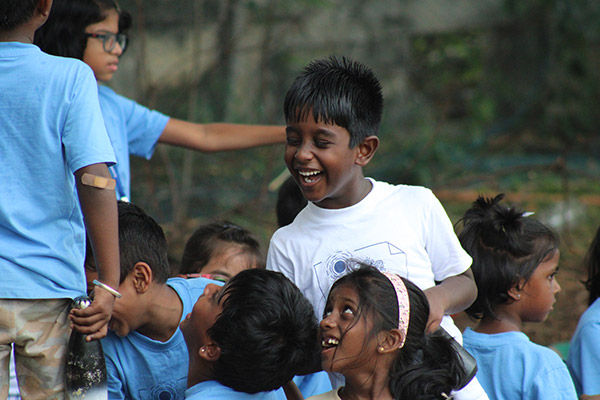Mindful Meditations for Work and Life
- Chettinad - Sarvalokaa Education

- Apr 15, 2020
- 6 min read
Updated: Jun 19, 2020
Meditation is a practice where we use mental exercise to train our attention and awareness in order to achieve mental clarity and a sense of calm. But why would we want to? Let's start with intention. What do you hope to achieve with meditation?
Think about that. Our happiness is not based on what's happening to us. It's all about how we react to what's happening to us. So for me it's really simple. I meditate because I want more of the good days and less of the bad. I want more days when I'm feeling really capable, and operating at my highest potential. I just want to be happy.Research shows there are lots of benefits to meditation, like reduced stress, reduced anxiety, lowering of blood pressure, improved emotional health and longer attention span. It can even help fight addictions, and enhance self-awareness.
Many people think that meditation is about not having thoughts. Not quite. The mind is going to produce thoughts, that's what it does. One important goal is to ignore the thoughts we have. We notice them, we let them pass by, but we stay neutral. Our thoughts are moving by, but we aren't moving with them. We're not tossed around by them. We're free from our thoughts. The next sign post is heightened awareness. When we meditate we often enter a state where we become more sensitive to outside stimulus - the ambulance sirens, the hum of the air-conditioning, maybe the kids playing outside. We become at ease and profoundly awake at the same time. A third sign post that you're doing it right is stillness, the quality of stillness.
How long should I do this?
Well, there's an old story about a student who goes to his teacher and asks, “How long should I meditate every day?” And the teacher says,“Mmm, you should meditate about an hour a day, but if you're really busy and you don't have time, then make it two hours.”
You know, it's when we think we don't have time and we're really stressed out that we probably need it the most. There's no right answer here. Research shows that 20 minutes, even as little as 10 minutes a day for a couple of months yields measurable benefits. I say keep all that in mind, and do what works for you. If you're having challenges building a habit, simply start with one to two minutes every day and build from there, and if you can work up to 20 minutes a day, that's great. But do what works for you. Make the practice fit you and your life, not the other way around.
The three breaths Practice
Sometimes you just need a quick practice to get centred. This exercise is only three breaths long and takes less than a minute. I might use this one if I'm about to step into a meeting that could be stressful, or if I'm in the middle of my work day and I need to focus or calm down. It's only three breaths, but those three breaths can create a break for our mind. We start to deactivate the fight or flight system and start to engage the parasympathetic system. It's just the right break to set us on a new, more focused, and clear path.
Three breaths practice to follow:
In this exercise, I'm going to guide you through breathing three times. We're going to take a deep breath in, we're going to hold that breath at the top and when you gently and slowly exhale, I'm going to give you a phrase to say inwardly. At the end of your exhale, you'll hold the breath outside of the body and then we'll repeat. Let's try it. (Deeply exhaling) Start by fully exhaling and then take a nice, long, slow inhale and hold it at the top. As you gently exhale and release that breath say to yourself: letting go. When you're done with the exhale, hold it outside of your body. Take a second slow inhale in, hold at the top, and as we release this breath say to yourself: being here. At the end of the exhale, hold it outside of the body and then take a third slow inhale, filling up completely and holding at the top and as you let it go, say to yourself: opening up. At the end of this third breath, just start to breath naturally and normally. Perhaps expressing some gratitude to yourself for taking this time. And when you're ready, you can gently open your eyes and return.
Preparation for visualization
Let's talk about visualization. I think of this as a performance-based meditation. In some traditions, meditation is used as a way of just being without much focus on a specific outcome. I really appreciate visualization as it helps me generate or create the life that I want. I sometimes use visualization to achieve a certain state. For example, if I'm headed into a meeting where I'm presenting, or I know that the meeting might be stressful, I might use visualization to access that confident part of myself. And while many meditations can leave us feeling very calm and relaxed, we can use visualizations or something similar to actually generate more energy. In the following exercise, we'll use visualization to create a sense of joy. But you could use the same technique to create a sense of confidence or strength, or nearly any other state you'd like to achieve.
Visualization practice
I invite you to find a comfortable but alert position, and just let your breathing extend. Let your inhalations, and exhalations stretch out, and just let the weight of the day fall away from you. Let your shoulders relax, your eyebrows relax. Let your molars relax and just be here.
Allow yourself to arrive in this moment. In this practice we're going to become joy. So with each breath in, breathe in joy. What does it feel like to breathe in joy? With each breath become a little lighter, a little freer. With each out breath, let go, let go of anything that is not joy. So when we breathe in, you're breathing in light, joy and happiness. And when we breathe out, we're letting go of anything that is not. I'm a visual person, so I like to use a colour for this. As we breathe in, we visualize a bright yellow, and having that yellow fill our body. So with each in breath we become lighter, freer, and I'm visualizing that bright yellow coming in, and with each exhale, I'm letting go of anything that is not joy.
If it's helpful you can visualize a dark colour on the exhale for anything that is not joy. We're breathing in bright yellow, and breathing out anything that's not bright yellow. With each breath we become freer, lighter, happier. Perhaps, it feels like our bodies are being lifted to the point where we're almost floating, and if we were to look at you from the outside, we might only see yellow, with no distinction between where the yellow and your body begin, and end.
Feel this in your body. Let it lift the corners of your mouth. Let it lift your shoulders. Perhaps even think of something that gives you great joy, wonder, curiosity, love, and let that bright yellow, that feeling just overwhelm you, melt all around you, expand from your centre in an infinite way, as your joy expands beyond you, into the universe, as if you are a shining sun, too bright to look at directly. Just deeply get a sense of that joy, of that lightness, and that infinite expansion, and know that you can return to this state whenever you like, whenever you need. Now that you've been here, you can access this more easily, more quickly, and when you're ready, you can return. Start to put some movement back into your body, into your fingertips, and gently open your eyes, bringing that joy with you.
Preparation for loving-kindness
There's some really fascinating research around compassion. We're effectively programmed to feel compassion for people in our in-group and not feel compassion for those in our out-group. And we see the result of this on the evening news, in our communities, in our politics, in the divisiveness that's on full display. That's the bad news, we're programmed this way. The good news is we can hack the system. When we are able to see the similarities we have with others instead of focusing on the differences, we increase our ability to have compassion for them. We increase our ability to be in a relationship with them and work together towards better common outcomes. In the work environment, we have a built-in advantage, because every member of our work group is, by definition, on the same team. We may not always see eye to eye, but if we can remember that we're all playing for the same team and we all want the same eventual outcome, we'll be better off.
We sometimes have this funny idea that meditation is a selfish pursuit. You know, instead of meditating, maybe I should be doing something more productive. Well, actually, I think it's more of a global imperative. When we take the time and do the work, we're more centred, we're more clear, less stressed, and we have a much better chance of helping our fellow humans. We're going to be more productive at work and we're going to be more present and loving with our families and better with all of our relationships. We're an upgraded version of ourselves.







Comments